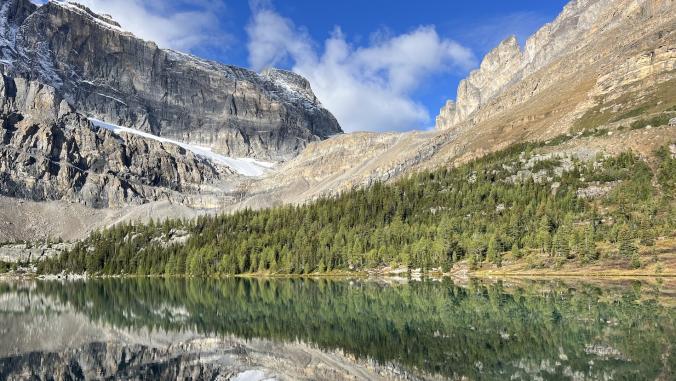Half the world’s GDP depends on natural resources, but only about 1 percent of total climate financing goes to support investments such as protecting forests, rehabilitating ecosystems or reestablishing water resources in developing countries. What’s more, only 14 percent of funding for nature-based solutions is supplied by the private sector — with much of the money today coming from public sources, such as grants.
Experts say the private sector needs to start stepping up.
"I think the private sector hasn’t done enough to understand their own climate-related financial risks to their assets," said Stacy Swann, CEO of Climate Finance Advisors, a consulting firm in Washington, D.C.
The World Economic Forum (WEF) estimates private sector financing for nature — such as for sustainable fisheries, conservation efforts to avoid biodiversity loss, the development of climate funds, voluntary carbon markets that protect nature and payments to land managers to protect watersheds or plant trees — amounts to about $18 billion per year. But the report also stated that all investment both public and private in nature-based solutions needs to triple by 2030 and quadruple by 2050 for a cumulative total investment of $8 trillion, an annual investment rate of $536 billion per year, if the world is to halt biodiversity loss and limit warming to 2 degrees Celsius.
While the WEF report outlines a $4 trillion gap to get to $8 trillion by 2050 to halt biodiversity loss and keep warming to 2C, the report's author, Teresa Hartmann, said business and society will probably need to invest more than that to keep the worst climate catastrophes from occurring.
"The risk is changing,” Swann said. "So even if you counted it all today, you'd be analyzing the value of those nature-based solutions on the climate risk we know about today. But next year, after we've locked in another year's worth of warming, that risk could be higher."
A new way of thinking
The concept of investing in nature is relatively new for the private sector. To start closing the gap and figure out what levels of spending might be justified, companies first need to evaluate their reliance on nature, according to the experts interviewed for this article.
For example, according to Swann, companies should start putting resources into understanding their risk profiles when it comes to the availability of certain natural resources or potential impacts related to extreme weather or increasingly frequent wildfires.
As an example, Swann outlined how an auto manufacturer that has a factory in South Carolina, a state that has been incredibly flooded by hurricanes in the last few years, might be at risk of losing those assets.
"If they did a climate-related financial risk assessment on those assets, and the solution set for managing those risks include a nature-based solution for adaptation, it could be less expensive than moving manufacturing from South Carolina back to Michigan," she said.
After building those risk scenarios, companies need to start putting a value on the natural resources that many businesses currently take for granted.
"The point is to show how many services you get for free from nature, and what the economic value of that is," said Martin Berg, head of the natural climate impact strategy at firm Climate Asset Management. "We're already seeing that biodiversity loss is starting to bite us."
When it comes to funding nature, according to Hartmann, most people's minds go directly to protection and conservation initiatives, which isn’t necessarily attractive to the private sector except in a philanthropic capacity. Climate Asset Management works with companies to create business models that not only protect nature from losses but will create economic value in the process. One example might include New Zealand dairy farms that have lost profit-value from decreasing milk prices. Those businesses might consider converting some land into reforestation projects, because the credits are more valuable than the milk.
Creating new innovative business models and markets related to nature-based solutions will help companies expand their thinking, Hartmann said. "We need better business models, better technologies, better operating models, better investment models," she said.
We need better business models, better technologies, better operating models, better investment models.
Aside from carbon offset markets based on forestry projects or regenerative agriculture, right now there aren’t many obvious ways for investors to make their money back on nature-based investments. Hartmann suggested ideas such as government subsidies for farmers investing in sustainable agriculture practices or the creation of tourism revenue streams related to conservation or biodiversity projects.
Consider these examples: The food company Danone opened up $3 million in government grant funding last year to farmers that started planting cover crops and moving to no-till agriculture. A cattle-rearing farm in Alabama added ecotourism activities including birding and nature trails to supplement the farm income. Other protected areas in Pakistan and in Patagonia are creating income with tourism while conserving the landscape.
"We still need to produce food, fiber, textiles and building materials," Hartmann said. "There are interesting models in restoration and regenerative agriculture and forestry that I do think can be very attractive for private sector investments."
One of the biggest hurdles to overcome when considered investments in nature-based solutions is that the results and payouts can take decades to occur. According to Swann, when nature-based solutions are funded, the financing focuses on the upfront costs but not what it’s going to take to maintain those investments over 100 years so that they continue to deliver resilience benefits as the climate continues to warm.
She advises companies to think about who will be responsible for the operation and maintenance costs at the precipice of a project to avoid confusion later down the road. By outlining this beforehand, there is less of a chance the project will be neglected when the initial money runs out, spoiling the potential and already accrued environmental benefits.
But Hartmann still thinks the biggest changes will come from regulatory change. She wants governments, particularly in the U.S., to tax biodiversity loss and create pools of money for the transition to regenerative agriculture the way they have for the COVID-19 recovery. She wants to see subsidy legislation, trade tariffs and tax regimes aligned with protecting nature that will, in turn, encourage private sector investment by making it desirable and profitable.
"A lot of the action that we’re actually seeing happening is all voluntary action," she said. "Voluntary action leads to government action."






